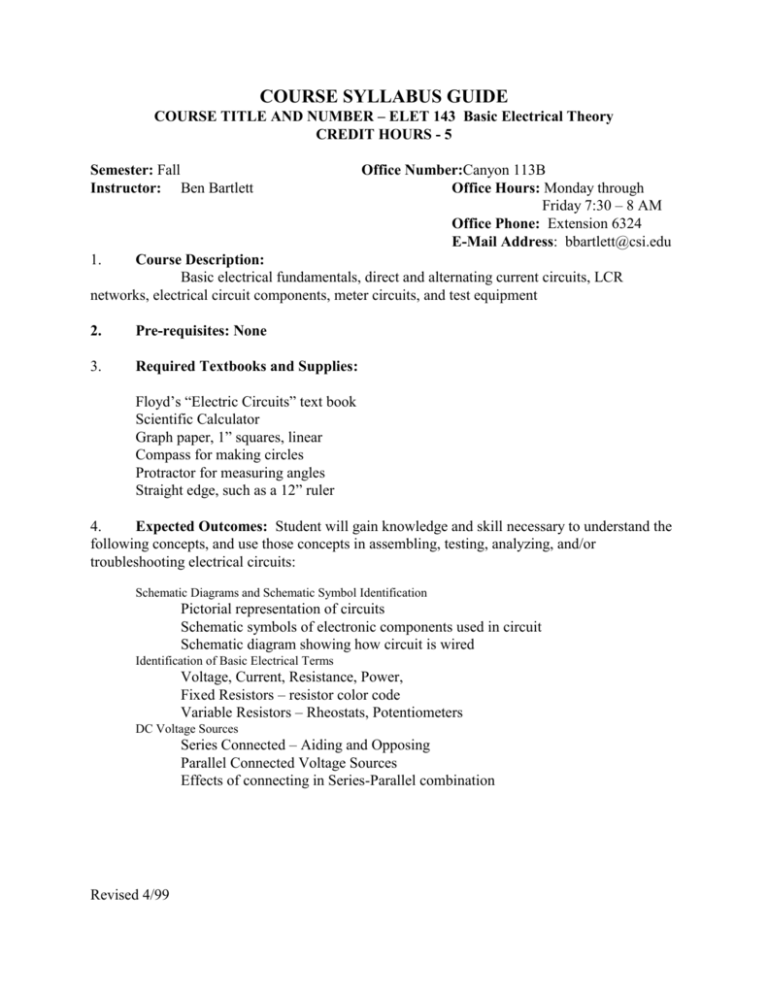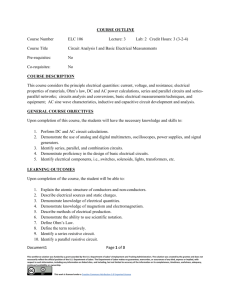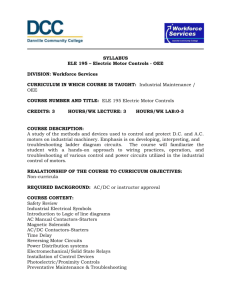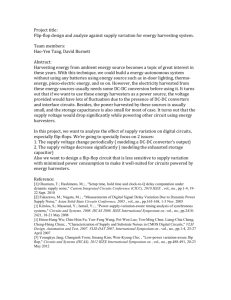Parallel Circuits
advertisement

COURSE SYLLABUS GUIDE COURSE TITLE AND NUMBER – ELET 143 Basic Electrical Theory CREDIT HOURS - 5 Semester: Fall Instructor: Ben Bartlett Office Number:Canyon 113B Office Hours: Monday through Friday 7:30 – 8 AM Office Phone: Extension 6324 E-Mail Address: bbartlett@csi.edu 1. Course Description: Basic electrical fundamentals, direct and alternating current circuits, LCR networks, electrical circuit components, meter circuits, and test equipment 2. Pre-requisites: None 3. Required Textbooks and Supplies: Floyd’s “Electric Circuits” text book Scientific Calculator Graph paper, 1” squares, linear Compass for making circles Protractor for measuring angles Straight edge, such as a 12” ruler 4. Expected Outcomes: Student will gain knowledge and skill necessary to understand the following concepts, and use those concepts in assembling, testing, analyzing, and/or troubleshooting electrical circuits: Schematic Diagrams and Schematic Symbol Identification Pictorial representation of circuits Schematic symbols of electronic components used in circuit Schematic diagram showing how circuit is wired Identification of Basic Electrical Terms Voltage, Current, Resistance, Power, Fixed Resistors – resistor color code Variable Resistors – Rheostats, Potentiometers DC Voltage Sources Series Connected – Aiding and Opposing Parallel Connected Voltage Sources Effects of connecting in Series-Parallel combination Revised 4/99 Identifying Types of Switches SPST toggle switches, DPST switch, DPDT switch Rotary Function Selector switches Momentary Contact Push Button switch Other miscellaneous switches, and switching concepts Ohm’s Law Basic relationship of Current, Voltage, and Resistance in a circuit Use of Ohm’s Law in analysis and troubleshooting of circuits Series Circuits Factors affecting total resistance, current flow, voltages, and power in a series circuit Troubleshooting series circuits Parallel Circuits Factors affecting total resistance, current flow, voltage, and power, of a parallel circuit Troubleshooting parallel circuit Series-Parallel Circuits Factors affecting total resistance, current flow, voltage, and power of a seriesparallel circuit Troubleshooting series-parallel circuits Voltage Divider Circuits Unloaded , and Loaded Voltage Divider Circuit Analysis Troubleshooting in Voltage Divider Circuits Current Divider Circuits Ideal Current Sources, Practical Current Sources, Troubleshooting Current Divider Circuits Voltage and Current Divider Circuits Applications of voltage and current divider circuits Troubleshooting in voltage and current divider circuits Meter Circuits DC ammeter, DC voltmeter, DC Ohmmeter Loading effect, and Insertion effect 5. Outcomes Assessment: Successful completion of the course will be evidenced by the ability to use the information gained to better understand subsequent topics, and by successfully completing the exams and other assignments, given during the course of the program. Revised 4/99 6. Policies and Procedures: 1. Attendance policy Students are expected to attend every class session and lab session. Students are expected to be in class at the prescribed time. Attendance is determined by a combination of time cards, and instructor observation, with the time cards being the main method of keeping attendance. However, coming in late, and/or leaving early, as observed by the instructor, will be counted as tardy. 2. 3. 4. 5. 6. 7. Hours of lecture each week – approximately 7 ½ hours Hours of lab each week – none (lab is a separate listing) Required assignments – Homework assignments count for 25% of grade Late policy – Student is considered late 6 minutes after the scheduled start of class Plagiarism statement – Student must do his/her own work, when composing reports, or other research projects. All research material, whether from Internet, Library, Magazine sources, or other printed media, must be indicated by references in the document. All references must be complete enough to allow validation by the instructor. Any violations of this policy (for example, copying of someone else’s material) will be punishable, up to, and including, dismissal from the program. Grading Practices: 1. Testing procedure – tests will be given on a periodic basis, generally once a week, depending on subject matter, and will normally be ‘open notes’ type tests. Some tests , however, will require memorization of the material, and will be ‘closed notes’, ‘closed book’ tests. 2. Grading Scale – 90% to 100% = A 80% to 89.9% = B 70% to 79.9% = C 60% to 69.9% = D below 60% = F 3. Attendance and Punctuality – Effect on Grade Student must maintain 60% or higher on quiz grades, to pass, no matter what the overall average is. Instructor also may adjust the grade up or down based on attendance and punctuality. Any student who misses more than the equivalent of 5 class sessions will begin to lose points. Each absense beyond the fifth absense will lower the numerical grade by 2 points. Each time the student is tardy 1 point will be deducted from the grade, after the total of 5 class sessions are missed. Therefore, 2 tardies count as 1 absence. Example: Student misses 4 complete days (4 absenses), and has 3 tardies. Each of the absenses count 2 points (4 x 2 = 8), and each tardy counts 1 point (3 x 1 = 3), so total points deducted from the students grade is 11 - 10 (5 class periods free) = 1 point Revised 4/99 So, if the student has a 74.5 % , his/her adjusted grade is now 74.5 - 1 = 73.5 % 8. Library Use if Applicable: - none assigned 9. Topical Outline for the Course Schematic Diagrams and Schematic Symbol Identification Identification of Basic Electrical Terms DC Voltage Sources Identifying Types of Switches Ohm’s Law Series Circuits Parallel Circuits Series-Parallel Circuits Voltage Divider Circuits Current Divider Circuits Voltage and Current Divider Circuits Meter Circuits Revised 4/99







